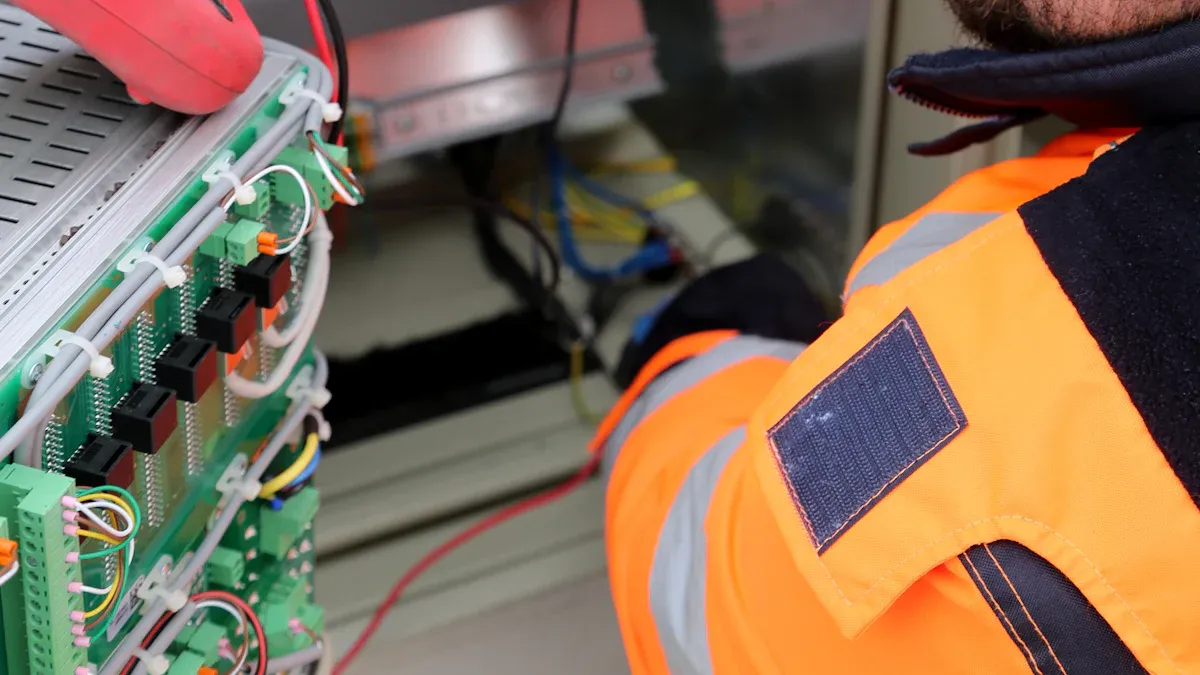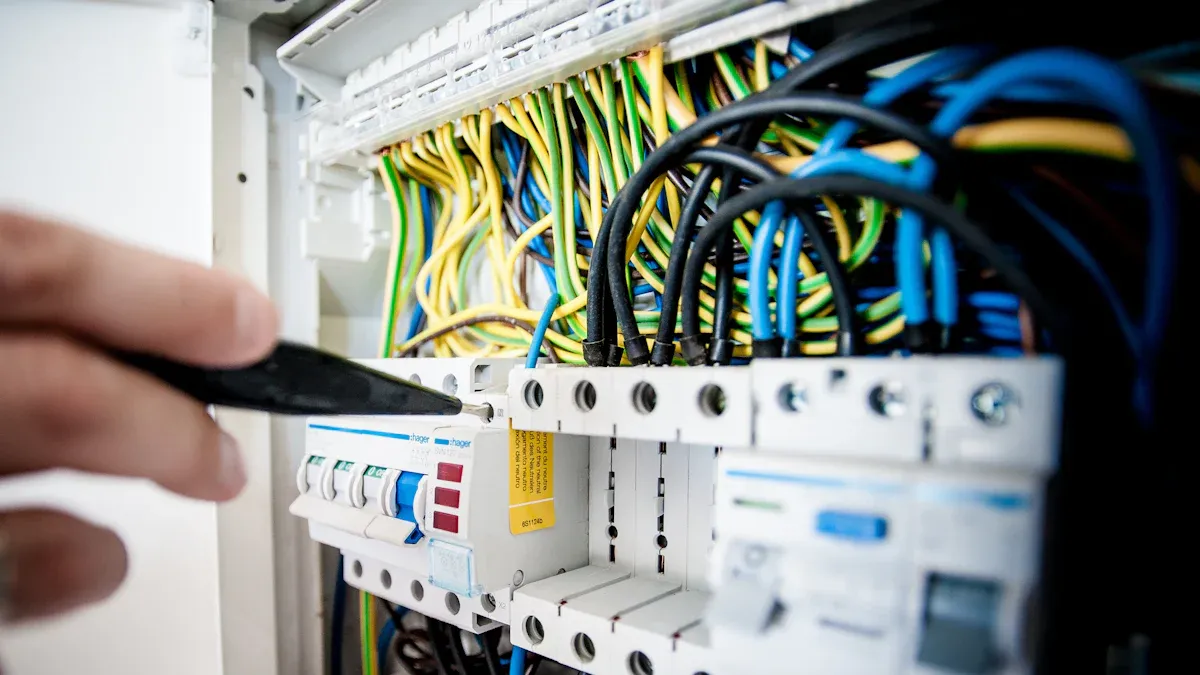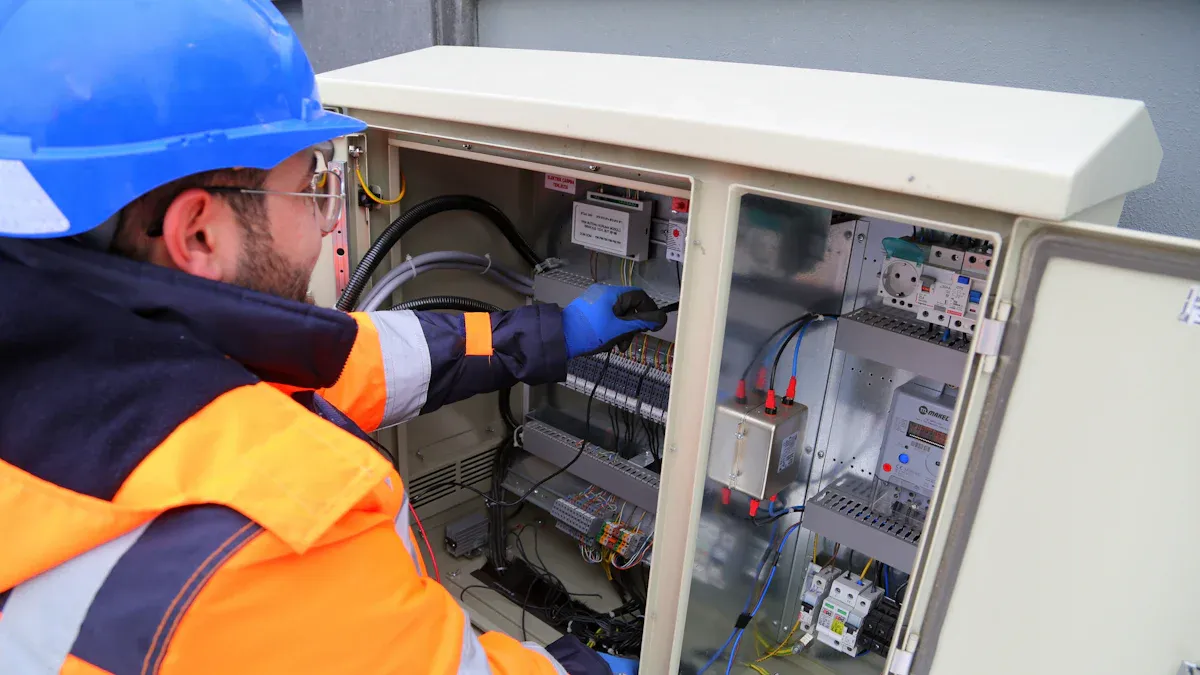
You want to put in an active harmonic filter to get better power quality and steady control of harmonics. Good installation keeps you safe, protects machines, and follows the rules. Power systems often have problems with harmonic distortion. This can break equipment or stop work. The SINAVA POWER Active Harmonic Filter uses smart technology to give strong and steady performance.
Key Takeaways
Check the site carefully before you start. Make sure there is enough room and good airflow for the active harmonic filter.
Always keep safety first when you install. Turn off the power. Use tools with insulation. Wear safety gear to stop accidents.
Follow the maker’s steps for mounting and wiring. This helps you avoid mistakes and makes sure it works well.
Check and take care of the active harmonic filter often. Clean it, look at the wires, and update the software to keep it working right.
Make sure you follow the rules after you finish. Check the Total Harmonic Distortion (THD) levels to see if your system is safe and works well.
Preparation
Site Assessment
Begin by looking at the site. Check if there is enough space for the SINAVA POWER active harmonic filter. Make sure air can move well around it. You need to get to the filter easily for future repairs. Look at the voltage at your site. See if it matches what the filter needs. Find things that cause harmonic distortion, like big electronic machines or variable frequency drives. Make sure the filter can handle the types of harmonics you have. Modern filters use a three-level inverter topology. This helps save energy and makes them work better. If you have single-phase loads or interharmonics, ask the manufacturer if the filter will work.
Tip: Modular filters like SINAVA POWER let you add more units later if you need more power.
Equipment Check
Check all your equipment before you start. Make sure you have the right active harmonic filter for your job. Look at all modules, cables, and mounting parts. Make sure nothing is broken or missing. Look at the human-machine interface (HMI) choices. SINAVA POWER has different HMI sizes. Pick the one that helps you watch your system best. Make sure you have the right software and ways to connect, like RS485 or Ethernet. Check that the filter can handle the harmonics at your site.
Safety Measures
Safety is very important. Turn off all power before you begin. Use tools that are insulated. Wear gloves and safety glasses. Follow all local electrical rules. Make sure the area is dry and clean. Check that the filter is grounded well. This stops electrical danger. If you have capacitor banks, make sure the filter can control them. This helps with power quality. Keep a fire extinguisher close. Never work alone.
Active Harmonic Filter Installation

Mounting
Pick a strong, flat spot for your active harmonic filter. Make sure there is enough space for air to move. You need to reach the filter easily for repairs. Keep the filter away from heat, water, and dust. Use the mounting brackets and hardware that come with the filter. Fasten the filter tightly so it does not shake.
People sometimes make mistakes when mounting. The table below shows common problems and ways to fix them:
| Common Mistake | Solution |
|---|---|
| Synchronization issues causing interharmonics | Ask the vendor if interharmonic sources are at your site. |
| Non-compliance with EMC guidelines | Make sure the filter has a tuned EMC-filter to stop interference. |
| Misunderstanding de-rating of filters | Get the de-rating curve from suppliers to know filter capacity at different loads. |
| Lack of commissioning software | Check that the filter has commissioning software for self-checks and diagnostics. |
Tip: Always use the manufacturer’s mounting instructions. This helps you avoid problems with harmonic compensation and keeps your system safe. 《How to Identify and Fix Common Static Var Generator Issues》
Electrical Connections
Connect the active harmonic filter to your electrical system carefully. Use cables that fit the load and voltage. Check all connections before you turn on the filter. Follow these steps for safe wiring:
| Step | Description |
|---|---|
| 1 | Connect the power input terminals to the mains source. |
| 2 | Use cables that can handle the filter’s load. |
| 3 | Connect the load-side terminal to the bus bar or panel for nonlinear loads. |
| 4 | Put current transformers (CTs) on the main power line phases for real-time current output. |
| 5 | Make sure CTs are mounted right to avoid errors in harmonic compensation. |
| 6 | Connect the filter’s control panel to the system for monitoring and programming. |
Always check the polarity and direction of the CTs. Wrong installation can cause poor harmonic filtering. Make sure the ground connection is tight. This keeps the filter and your power system safe.
Note: Never skip checking for good insulation and tight terminals. Loose connections can cause overheating and lower the quality of harmonic correction.
System Integration
Plan carefully when you add the active harmonic filter to your system. Start by finding out what harmonic filtering your facility needs. Look at the frequency range and noise levels. Pick the right filter type for your job. Design the filter circuit with the right software. Test the circuit with a simulation before you install it.
Follow these steps for the best results:
Find out your filter needs, like types of harmonic distortion and noise levels.
Pick the right filter type for your system.
Design the filter circuit with the correct parts.
Simulate the circuit to see how it works.
Build a prototype if you need to.
Test the prototype for frequency response and gain.
Connect the active harmonic filter to your system.
Make final changes to get the best performance.
You may have problems during integration. These can be hard designs, installation troubles, or maintenance issues. You might also see limits in performance or risks like resonance and instability. You can fix these problems by following the manufacturer’s instructions and using the right commissioning software.
⚡ Alert: Always follow local electrical codes and standards. This keeps your power system safe and makes sure the active harmonic filter works right.
A well-installed active harmonic filter will make your power quality better. It will lower harmonic distortion and protect your equipment. Your electrical systems will work better and last longer.
Commissioning and Testing

Initial Power-Up
You must start the active harmonic filter carefully. First, check that all wires are tight and safe. Make sure the filter is grounded well. Turn on the main power supply. Watch the filter’s Human-Machine Interface (HMI) for warning lights or error codes. If you see a problem, turn off the power and check the wires again. Wait for the filter to finish its self-check. The SINAVA POWER system will show when it is ready. You can use the HMI to set basic settings. Make sure the filter matches your site’s voltage and load.
⚡ Tip: Always write down what happens at first start-up. Record any error messages or strange sounds.
Performance Check
After the filter turns on, you need to check how it works. Use the HMI or monitoring software to look at harmonic levels. Compare the numbers before and after you install the filter. The table below shows what you should see:
| Metric | Before Installation | After Installation | Improvement |
|---|---|---|---|
| Total Harmonic Distortion Index | 28% | 4% | Reduced by 24% |
| Compliance with IEEE Standards | No | Yes | Achieved compliance |
| Annual Utility Penalties | $74,000 | $0 | Eliminated penalties |
| Motor Failures Due to Overheating | High | Low | Reduced by 62% |
You should see a big drop in harmonic distortion. The active harmonic filter helps your power system work better. You will notice fewer motor failures and no utility penalties. The filter makes your electrical system stronger.
Compliance Verification
You must check that your system follows all rules. Look at the Total Demand Distortion (TDD) and Total Harmonic Distortion (THD) values. Industry rules say TDD should not go over 5% at the Points of Common Coupling (PCC). Many filters can lower THD to 4%. Use the table below to check the main standard:
| Compliance Standard | Requirement | Description |
|---|---|---|
| IEEE 519 | THDi < 5% | Makes sure the Total Harmonic Distortion in current stays below 5%. This is important for good and safe electrical systems. |
If your readings meet these standards, your active harmonic filter works well. You have a safe and reliable power system.
Working Principle of Active Harmonic Filters
Real-Time Monitoring
To understand how active harmonic filters work, start with real-time monitoring. The filter uses current sensors and digital tools to watch your power system all the time. It checks for harmonic distortion every second. The filter looks for unwanted harmonic currents. It uses dynamic filtering to find only the bad frequencies. Selective compensation helps the filter fix just the problems that matter.
Active harmonic filters use real-time technology to make power better.
The filter always checks electrical signals for harmonic problems.
It acts fast to keep total harmonic distortion under 5%. This meets industry rules.
Real-time monitoring uses current sensors and digital tools to check load current all the time.
Selective compensation only fixes the harmonic frequencies in your system.
This real-time monitoring keeps your power system steady. You can spot problems right away and fix them fast. The SINAVA POWER active harmonic filter makes this easy with smart monitoring features.
Harmonic Compensation
Active harmonic filters also use harmonic compensation. When the filter finds harmonic distortion, it figures out the right compensation current. The filter sends out a current that is the same size but goes the other way. This cancels out the unwanted harmonic currents. It lowers total harmonic distortion.
You get many good things from this process:
| Benefit | Description |
|---|---|
| Improved Power Quality | The filter keeps voltage steady and stops equipment from breaking due to heat or distortion. |
| Enhanced Equipment Longevity | Machines last longer because cleaner signals stop breakdowns from harmonic currents. |
| Lower Maintenance Costs | You pay less for repairs since your equipment does not wear out as fast. |
| Energy Savings | Many factories save up to 20% on electricity bills after using a harmonic filtering system. |
The SINAVA POWER active harmonic filter uses real-time monitoring and harmonic detection for fast and correct compensation. You get a strong power system with less harmonic distortion and better quality.
Maintenance and Troubleshooting
Routine Monitoring
You need to check your active harmonic filter often. This helps your system work well. Start by cleaning the filter box and all its parts. Look at the wires and make sure they are tight. Test each part to see if it is worn out or broken. Change any parts that do not work right. Update the filter’s software if you need to. Look at the filter’s data to see if anything has changed.
Follow these steps for routine checks:
Clean the filter and its box.
Check all wires and connections.
Test for broken or worn parts.
Change bad parts.
Update the software.
Look at how the filter is working.
You should also measure harmonics at the filter’s input and output. Use a power quality analyzer for this. Compare new numbers with old ones. Check the filter’s heat, noise, and lights. Watch for errors or alarms in the logs.
| Tool Name | Description |
|---|---|
| HarmonicGuard Solution Center | Free software that helps you choose filters and check harmonics. |
| EasyPower Harmonic Analysis | Software that finds and helps fix harmonic and power problems with strong tools. |
Preventive Maintenance
You can help your filter last longer by doing regular checks. Watch harmonics all the time to find changes fast. Look at your data often to spot new problems. Use good habits to keep your power quality high.
Check the filter often to make sure it works.
Change any parts that are worn out.
Look at connections and watch how the filter works.
Clean the heat sink and check the fan to stop it from getting too hot.
Write down all the work you do.
Plan your checks before you start. Use safe tools and follow safety rules. Write down what you find and fix. Change your plans as you learn more.
Common Issues
You may see some common problems with active harmonic filters. Overcurrent can happen if the filter gets too much current. Thermal overload may happen if the cooling system fails or the filter works too hard. Communication failures can stop the filter from talking to other systems. Power supply problems may make the filter reset or stop. Parts like capacitors or IGBTs can break and stop the filter.
| Common Faults | Description |
|---|---|
| Overcurrent | The filter gets too much current, often from sudden load changes. |
| Thermal Overload | The filter gets too hot if cooling fails or it works too hard. |
| Communication Failures | Problems with data links between the filter and control systems. |
| Power Supply Issues | Changes or breaks in power can cause resets or problems. |
| Component Failures | Inside parts like capacitors or IGBTs can break and lower filter function. |
If your filter does not work right, check for harmonic distortion. Use a power quality analyzer to see if total harmonic distortion is too high. Find out if the problem comes from before or after the filter. Fix the problem by balancing loads, changing equipment, or moving how loads connect.









